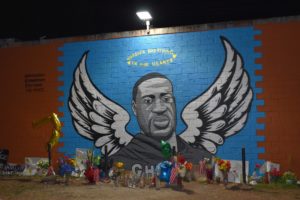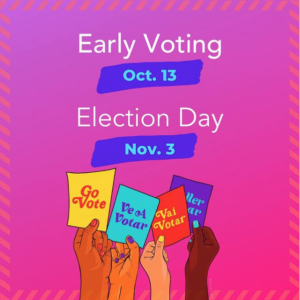Just like wildfire.
 Social media is like wildfire. The speed at which information spreads through the medium is rather impressive, and you can’t help but stare and be drawn to the flame. And, perhaps, fan the flame. The viral nature of social media makes it the perfect partner for inciting change when it comes to critical issues like social injustice.
Social media is like wildfire. The speed at which information spreads through the medium is rather impressive, and you can’t help but stare and be drawn to the flame. And, perhaps, fan the flame. The viral nature of social media makes it the perfect partner for inciting change when it comes to critical issues like social injustice.
The pairing isn’t new, in fact in 2010, activists harnessed the power of the internet to gather and share the energy of their protests in what was known as Arab Spring, a series of anti-government protests and uprisings that spread across much of the Arab world. More than a decade later, social media is still changing the way activists communicate, come together, and mobilize.
Twitter was hatched just a year prior to Arab Spring, but should it have been utilized like it is today, one can only imagine…
Spreading awareness.
It isn’t always about protesting. Other activists have been able to share their voices and spread awareness in viral campaigns like the #MeToo movement and the ALS Ice Bucket Challenge. With the #MeToo movement, individuals and groups were able to stand up against sexual abuse and sexual harassment, virtually congregating in declaring “me too” in order to share stories and encourage change while opening a discussion about a topic often hushed. With the ALS Ice Bucket Challenge, Pete Frates, who was diagnosed with ALS, alongside two buddies from college, popularized the ice bucket challenge to raise awareness for the disease that would later take his life. Frates, a former Boston College baseball captain, raised more than $115 million for ALS research through the challenge, but the widespread participation (17 million people, resulting in 2.5 million donors), brought the disease awareness that would have never happened otherwise.
Starting a movement.
 The #BlackLivesMatter movement on social media started in 2013 following the acquittal of George Zimmerman in the death of Trayvon Martin. The hashtag and the movement trended for a while but faded out until the Ferguson protests brought it back to the forefront. Fast forward to the summer of 2020 when the video of George Floyd’s horrible death was shared on social media, the movement was reignited and spread like wildfire online. With everyone on social media 24/7 since the start of the COVID-19 pandemic, the news of the incident spread faster than ever before. In fact, in two days, there were 86,000 posts with the hashtag #BlackLivesMatter. This moment in time caused one of the biggest social media movements ever that also spilled over into massive offline protests and actions, and emphasized the necessity of long-term change, and not just the clicking of a button.
The #BlackLivesMatter movement on social media started in 2013 following the acquittal of George Zimmerman in the death of Trayvon Martin. The hashtag and the movement trended for a while but faded out until the Ferguson protests brought it back to the forefront. Fast forward to the summer of 2020 when the video of George Floyd’s horrible death was shared on social media, the movement was reignited and spread like wildfire online. With everyone on social media 24/7 since the start of the COVID-19 pandemic, the news of the incident spread faster than ever before. In fact, in two days, there were 86,000 posts with the hashtag #BlackLivesMatter. This moment in time caused one of the biggest social media movements ever that also spilled over into massive offline protests and actions, and emphasized the necessity of long-term change, and not just the clicking of a button.
We’ve got your back.
Just days following George Floyd’s murder, and ensuing protests, Nike was the first influential brand to make a statement.
 Nike, which previously established its stance by supporting Colin Kapernick in his protests in the NFL, has aligned itself with its athletes. Nike CEO John Donahoe said, “We will always lead with the athlete’s voice,” in the Wall Street Journal when asked how he decided which social issues the company should support. This thought process led Nike to the forefront of the #BlackLivesMatter movement, as well as sustainability and global climate change. And, while Nike has recently been touted for its support of women’s empowerment, the effort began back in 1995 with the “If you let me play sports” campaign...The lesson here? Big brands have a voice like no other and, used wisely and genuinely, can generate social good, while reaffirming and elevating their brand mission.
Nike, which previously established its stance by supporting Colin Kapernick in his protests in the NFL, has aligned itself with its athletes. Nike CEO John Donahoe said, “We will always lead with the athlete’s voice,” in the Wall Street Journal when asked how he decided which social issues the company should support. This thought process led Nike to the forefront of the #BlackLivesMatter movement, as well as sustainability and global climate change. And, while Nike has recently been touted for its support of women’s empowerment, the effort began back in 1995 with the “If you let me play sports” campaign...The lesson here? Big brands have a voice like no other and, used wisely and genuinely, can generate social good, while reaffirming and elevating their brand mission.
The butterfly effect.
 With brands as big as Nike leading the way, other brands and individuals continue to join the movement. The support for Black creators, Black-owned businesses, and Black-led activist movements increased drastically because of social media’s ability to share so quickly. According to the New York Times, an estimated 15 to 26 million participated in Black Lives Matter protests in the United States alone.
With brands as big as Nike leading the way, other brands and individuals continue to join the movement. The support for Black creators, Black-owned businesses, and Black-led activist movements increased drastically because of social media’s ability to share so quickly. According to the New York Times, an estimated 15 to 26 million participated in Black Lives Matter protests in the United States alone.
One of the biggest takeaways from Nike’s approach is that brands—for-profit and nonprofit—need to evaluate their audience and their constituents to ensure brand values align with the causes they are supporting. The more in tune you are with your ‘why’ and your audience’s values, the easier it will be to authentically embrace a movement.
Social media is important for every brand, including nonprofits when approached correctly. It requires intention to captivate your audience. If you are newly introducing your brand to social media, research before deciding what platforms are most impactful, scout your competitors and find out where your target audiences go for information. You will find success in creating and amplifying your voice.
Get moving on your content.
- Thoughtfully identify your platforms: More isn’t always better. If you have a small staff or do not have much time for social media, consider your choice in platform. You do not need to be on all of them. Identify who you are targeting, find out where they are and what they like, and hone in.
- Develop a strategy: Having a strategy and a social media calendar will set you up for success. Being armed with a solid plan allows you to set your brand’s tone and establish precedent of your voice. It also allows for foresight and flexibility as events happen in our society.
- Resources: Take advantage of free resources to enhance your content. Platforms like Canva and Adobe Spark provide free graphic templates, and Buffer and Hootsuite provide free options for scheduling.
Examples:
 Our client, Jolt Action, is the largest Latino progressive organization in Texas, and leading up to the 2020 election, Jolt put an emphasis on one of its key focuses, voter engagement. With one in three eligible voters in Texas being Latino, and almost 210,000 Latinos turning 18 every year, the importance of increased voter engagement is vital to Jolt’s mission to bring together Latinos from across Texas to win on the issues that matter. Jolt’s social media presence during the campaign stood true to its mission. On Instagram and other channels, Jolt consistently encouraged its followers to register to vote, then to actually go out and vote, all while also providing educational information through podcasts and graphics on different, relevant topics. As a result of Jolt’s, and other organization’s efforts, Latinos in Texas broke records for showing up to vote in the 2020 election. Jolt knew its audience, where they spend time, and their mission and values, and used social media to successfully amplify the cause.
Our client, Jolt Action, is the largest Latino progressive organization in Texas, and leading up to the 2020 election, Jolt put an emphasis on one of its key focuses, voter engagement. With one in three eligible voters in Texas being Latino, and almost 210,000 Latinos turning 18 every year, the importance of increased voter engagement is vital to Jolt’s mission to bring together Latinos from across Texas to win on the issues that matter. Jolt’s social media presence during the campaign stood true to its mission. On Instagram and other channels, Jolt consistently encouraged its followers to register to vote, then to actually go out and vote, all while also providing educational information through podcasts and graphics on different, relevant topics. As a result of Jolt’s, and other organization’s efforts, Latinos in Texas broke records for showing up to vote in the 2020 election. Jolt knew its audience, where they spend time, and their mission and values, and used social media to successfully amplify the cause.
American Red Cross does a solid job on social media of amplifying its brand and values. As a large nonprofit, the organization has the resources to be on all platforms, and knows the value of each platform, providing different content for various audiences on each channel. American Red Cross’s Twitter and Facebook feeds are very news-focused, and while its TikTok is also informational, it provides insight in a fun and youthful way. The American Red Cross Instagram page displays a diverse picture set, not only of the people captured on camera, but of the work Red Cross does, and the page provides a perfect example of how to be prepared by knowing your values and your audience. On June 16, 2020, the organization shared two photos, the first of a George Floyd mural, and the second of volunteers at work at a location of a protest. The opening sentence of the post really hits home to long-held values—“The #RedCross was born out of the desire to alleviate human suffering wherever it’s found.”
Don’t wait, start today.
If you are looking for additional support with social media or establishing your value-aligned voice, or don’t know where to start, Bloom Communications can be a valuable resource. Bloom has successfully navigated initiatives to help increase awareness around different causes and has also provided guidance on how to align a brand’s voice with its established values.
Get in touch with us and schedule a free consultation.
